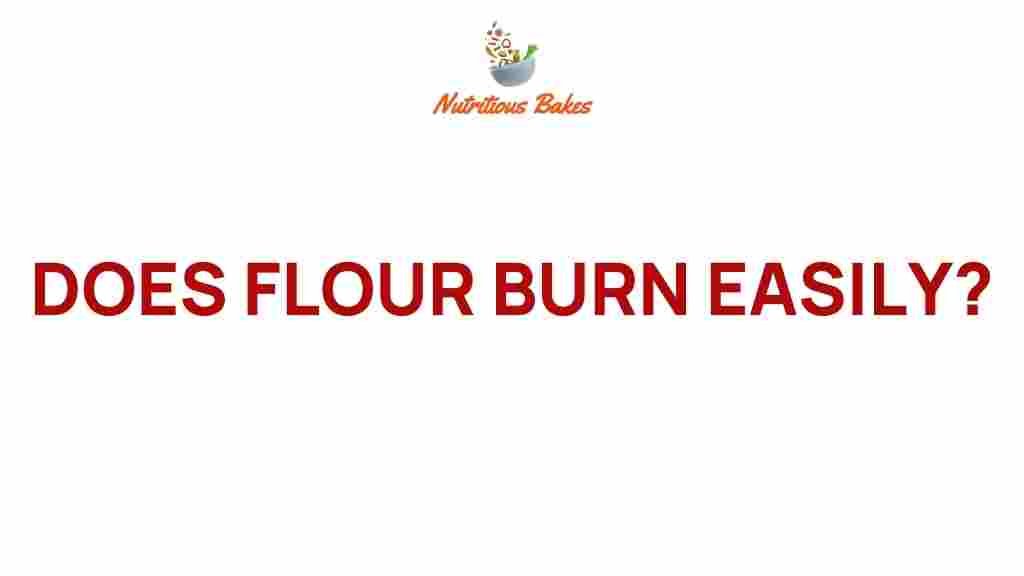The Surprising Truth: Does Flour Burn Easily in Your Kitchen?
When it comes to cooking and baking, flour is a staple ingredient found in almost every kitchen. However, many home cooks wonder about flour’s safety and its potential to burn during food preparation. In this article, we explore the surprising truth about flour and whether it easily burns in your kitchen. We will cover essential cooking tips, kitchen safety, and dive into some food science to understand how flour behaves under different cooking techniques. Let’s embark on this culinary journey together!
Understanding Flour and Its Properties
Flour is made from ground grains, primarily wheat, and it comes in various types, including all-purpose, whole wheat, and specialty flours. Each type of flour has unique properties that can affect how it performs in cooking and baking. Here are some key points about flour:
- Moisture Content: The moisture level in flour can influence its susceptibility to burning.
- Particle Size: Finer flours may burn more easily than coarser ones.
- Fat Content: Flours with higher fat content, like almond flour, may behave differently under heat.
Understanding these properties can help you make informed decisions when using flour in your culinary experiments.
The Science of Burning Flour
When we talk about flour burning, we need to differentiate between two concepts: burning and browning. Burning occurs when flour reaches a high enough temperature to produce smoke and char, while browning is a desirable reaction that enhances flavor and color.
Flour itself does not burn easily on its own. However, when combined with fats or subjected to direct heat, it can burn quickly. Here are some scenarios to illustrate this:
- Direct Heat: If flour is exposed to direct flame (like on a stovetop), it can burn rapidly.
- High Temperatures: Baking at excessively high temperatures can lead to burning, especially if the flour is not mixed properly with other ingredients.
- Prolonged Cooking: Leaving flour-based mixtures unattended can lead to burning, particularly in sauces or batters.
Cooking Tips for Preventing Flour from Burning
Now that we understand the science behind flour and burning, let’s discuss some practical cooking tips to prevent flour from burning in your kitchen:
- Mix Properly: Always ensure flour is mixed thoroughly with other ingredients to avoid direct exposure to heat.
- Control Temperature: Use moderate heat settings when cooking flour-based dishes to minimize burning risks.
- Stir Often: When cooking sauces or gravies that contain flour, stir frequently to prevent sticking and burning.
- Use a Double Boiler: For delicate mixtures, consider using a double boiler to maintain gentle heat.
- Keep an Eye on It: Never leave flour-based dishes unattended on the stove or in the oven.
Step-by-Step Guide: How to Safely Use Flour in Your Kitchen
Using flour safely in the kitchen involves both understanding its properties and applying effective culinary techniques. Here’s a step-by-step guide to help you:
Step 1: Choose the Right Flour
Select the appropriate type of flour for your recipe. For instance, use all-purpose flour for most baking and cooking needs, while whole wheat flour is better for hearty breads.
Step 2: Measure Accurately
Accurate measurements are crucial. Use a kitchen scale or measuring cups to ensure you have the right amount of flour.
Step 3: Combine Ingredients
When mixing flour with liquids or fats, do so gradually. This helps prevent lumps and ensures even cooking.
Step 4: Monitor Cooking Time and Temperature
Keep an eye on your dish as it cooks. Adjust the heat as needed to prevent burning.
Step 5: Cool Down Properly
After cooking, allow flour-based dishes to cool down gradually. This prevents moisture loss and further cooking that can lead to burning.
Troubleshooting Common Flour Burning Issues
Even with the best precautions, sometimes flour can still burn. Here are some common issues and how to troubleshoot them:
- Problem: Flour burns on the stovetop while making a roux.
- Solution: Reduce heat and stir constantly. If it burns, start over with fresh flour.
- Problem: Cake or bread crusts are too dark.
- Solution: Lower the oven temperature and check for doneness earlier in the baking process.
- Problem: Flour-based sauces have a burnt taste.
- Solution: Strain the sauce to remove burnt bits and start fresh with low heat.
Exploring Kitchen Safety with Flour
Kitchen safety is paramount, especially when dealing with ingredients like flour. Here are some tips to ensure a safe cooking environment:
- Store Flour Properly: Keep flour in a cool, dry place in airtight containers to prevent spoilage.
- Clean Up Spills: Flour spills can create a slippery surface; clean them up immediately to avoid accidents.
- Use Protective Gear: When handling hot mixtures, use oven mitts and aprons to protect yourself from burns.
Conclusion
In conclusion, flour does not burn easily on its own, but under certain conditions, it can be prone to burning. By understanding the properties of flour, applying effective cooking tips, and following safety guidelines, you can minimize the risk of burning flour in your kitchen. Remember, cooking is as much about experimentation as it is about technique. So, embrace those kitchen experiments and enjoy the culinary journey!
For more cooking tips and kitchen safety advice, check out our other articles on food preparation techniques. And for further reading on the science of cooking, visit this resource.
This article is in the category Tips and created by NutritiousBakes Team
